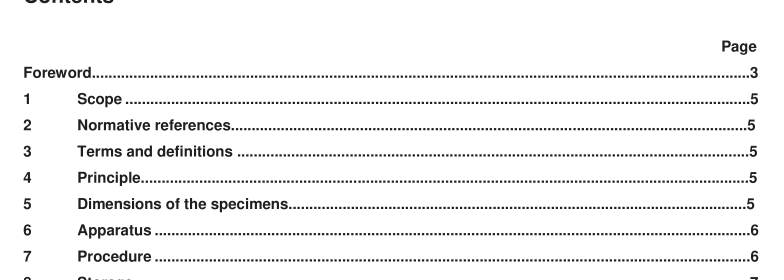BS EN 13286-50:2004 – Unbound and hydraulically bound mixtures — Part 50: Method for the manufacture of test specimens of hydraulically bound mixtures using Proctor equipment or vibrating table compaction

1 Scope
This document specifies a test method for making cylindrical specimens of hydraulically bound mixture to a predetermined density using Proctor equipment or vibrating table compaction. The method is appropriate for mixtures, or that part of a mixture, containing aggregate up to a maximum size of 31 ,5 mm.
2 Normative references
The following referenced documents are indispensable for the application of this document. For dated references, only the edition cited applies. For undated references, the latest edition of the referenced document (including any amendments) applies. EN 1 3286-2:2004, Unbound and hydraulically bound mixtures Part 2: Test methods for the determination of the laboratory reference density and water content Proctor compaction EN 1 3286-5, Unbound and hydraulically bound mixtures Part 5: Test method for laboratory reference density and water content Vibrating table
3 Terms and definitions For the purposes of this document, the terms and definitions given in EN 1 3286-2:2004 and the following apply.
3.1 Proctor rammer or vibrating table compaction method for making laboratory test specimens of hydraulically bound mixtures by compacting the mixture into a Proctor mould of known volume using either Proctor rammer compaction or high frequency vibration table until a predetermined density is achieved
4 Principle
Cylindrical test specimens of the mixture are prepared using Proctor moulds conforming to EN 1 3286-2. The mould is filled with the mixture in a specified manner and the mixture is compacted to a predetermined density by a Proctor rammer conforming to EN 1 3286-2 or by vibrating table conforming to EN 1 3286-5. After compaction, the specimens are stored, moulded or demoulded, at a specified temperature, moisture condition and period of time until required for testing.
5 Dimensions of the specimens
Specimens shall conform to the dimensions given in Table 1 .
6 Apparatus
6.1 Moulds, conforming to EN 1 3286-2. The mould size shall be selected from Table 1 .
The moulds shall have extension collars not less than 1 00 mm high to facilitate filling.
NOTE To facilitate demoulding, the use of split moulds may be appropriate.
6.2 Rammers, conforming to EN 1 3286-2.
6.3 Vibrating table, conforming to EN 1 3286-5.
A surcharge plug of a suitable mass (usually up to 1 2 kg) shall be used. The surcharge plug shall fit inside the extension collar and shall have gradations to judge that the required height of the specimen is achieved.
NOTE The weight of the surcharge depends on the nature of the material and the size of the mould.
7 Procedure
7.1 Mixture
Calculate the mass of the mixture required using the following formula:
where
m is the mass of the specimen, in grams (g);
V is the volume of the specimen, in cubic millimetres (mm 3 );
ρd is the dry density of the specimen, in megagrams per cubic metre (Mg/m 3 );
w is the water content of the dry mass of the mixture, in percent (%).
NOTE The values of dry density and water content used in the formula will vary according o experience and practice.
For example, the values may correspond to the Proctor density and the optimum water content or optimum water content –1 %.
BS EN 13286-50:2004 – Unbound and hydraulically bound mixtures — Part 50: Method for the manufacture of test specimens of hydraulically bound mixtures using Proctor equipment or vibrating table compaction